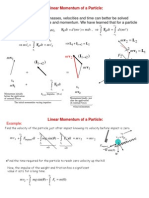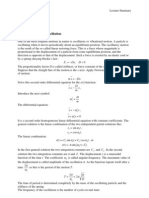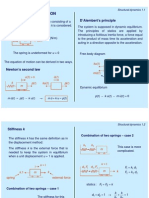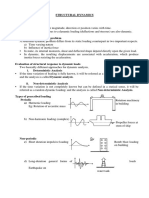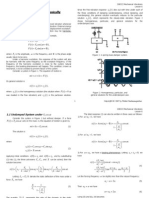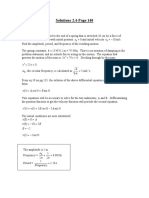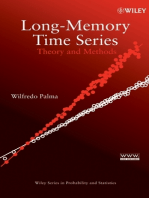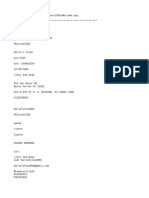Chapt 4
Uploaded by
Harvish SonarChapt 4
Uploaded by
Harvish SonarChapter IV
Forced/Driven Oscillations
Without Damping
t cos F x k
t d
x d
m
0
2
2
e = +
: e
Angular frequency of driving force
Or,
t cos
m
F
x
t d
x d
0
2
0
2
2
e = e +
An additional externally applied harmonic
force acts on the oscillator
:
0
e
Natural angular frequency
) X x ( k F =
t cos A X e =
Equation of motion :
) t cos A x (
dt
x d
2
0
2
2
e e =
Or,
t cos A x
dt
x d
2
0
2
0
2
2
e e = e +
Ex1. Spring-mass system with oscillating
fixed point
O
x
X
Pendulum With Oscillating Point of
Suspension
t cos A X e =
In the x-y frame, which is
non-inertial, the forces
acting on the bob are
shown in the figure.
The restoring force is :
fict rest
f sin T F u =
The fictitious force is :
t cos A m X m f
2
fict
e e = =
Ex. 2
t cos A m
x
T
2
e e =
x
y
mg
T
X
fict
f
u
O
x
Balancing forces along y, T cos T g m ~ u =
Equation of motion :
( ) A m F t cos
m
F
x
t d
x d
2
0
0
2
0
2
2
e = e = e +
Or,
|
.
|
\
|
e e = t cos A x
g
m
t d
x d
m
2
2
2
t cos E e F
0 drive
e =
Ex3. Electromagnetic wave incident on an atom
Eq. of motion of electron:
t cos
m
E e
x
t d
x d
0
2
0
2
2
e = e +
Ex. 4 A swing being pushed at regular interval
Does not quite fit the bill, as the driving
force is not harmonic, though periodic
F
Periodic force, pushing the swing
F(t)
t
...... t 3 cos A t 2 cos A t cos A ) t ( F
3 2 1
+ e + e + e =
T
T
2t
= e
t cos
m
F
x
t d
x d
0
2
0
2
2
e = e +
The above is a linear, inhomogeneous
differential equation.
0 x
t d
x d
2
0
2
2
= e +
The homogeneous part of the equation is :
Solving the Equation of Motion
Theory of linear diff. equation :
) t ( x ) t ( x ) t ( x
s . p 0
+ =
M.G.S of
Inhomoge-
neous
Equation
=
M.G.S of
homoge-
neous
Equation
+
Any
particular
soln. of
Inhomoge-
neous
Equation
A particular solution of the equation of
motion of the driven oscillator :
t cos
m
F
x
t d
x d
0
2
0
2
2
e = e +
Complex form :
t i
0
2
0
2
2
e
m
F
z
t d
z d
e
= e +
Guess Solution :
t i
e A ) t ( z
e
=
Putting this into the equation :
m
F
) ( A
0
2 2
0
= e e
Or,
) ( m
F
A
2 2
0
0
e e
=
t cos
) ( m
F
x
2 2
0
0
s . p
e
e e
=
Most general solution for the driven oscillator :
t cos
) ( m
F
) t cos( A ) t ( x
2 2
0
0
0
e
e e
+ | + e =
With the initial conditions :
0 ) 0 ( x ) 0 ( x = =
2
t ) (
sin
2
t ) (
sin
) ( m
F 2
) t ( x
0 0
2 2
0
0
e + e
(
e e
e e
=
) t ( x
t
The amplitude of the oscillations :
) ( m
F
) ( A
2 2
0
0
e e
= e
varies with the driving frequency e
= e
e e
) ( A
im
0
Resonance
) ( A e
e
0
e
Forced Oscillations with Damping
Equation of Motion :
t cos
m
F
x
dt
dx
dt
x d
0
2
0
2
2
e = e + +
To obtain the particular solution, take the
complex form :
t i
0
2
0
2
2
e
m
F
z
dt
z d
dt
z d
e
= e + +
To obtain a particular solution, the obvious
choice is :
t i
c s . p
e A ) t ( z
e
=
Substitution and subsequent solution for A
gives :
] i ) [( m
F
A
2 2
0
0
c
e + e e
=
) i ( m
e F
z
2 2
0
t i
0
s . p
e + e e
=
e
2 2 2 2 2
0
) t ( i
0
) ( m
e F
e + e e
=
o e
|
|
.
|
\
|
e e
e
= o
2 2
0
1
tan ;
) z ( Re x
s . p s . p
=
2 2 2 2 2
0
0
) ( m
) t ( cos F
e + e e
o e
= ) t ( cos ) ( A o e e =
Most General Solution :
) t ( cos ) ( A ) t ( cos e B ) t ( x
0
t
2
o e e + | + e =
Transient Steady State
The transient part of the solution dies out
after about Q oscillations, and after that the
steady state oscillations go on unabated
0
e
e
t
2 t
) (e o
0
e
e
) ( A e
k
F
0
m
e
2 2 2 2 2
0
0
) (
m F
) ( A
e + e e
= e
|
|
.
|
\
|
e e
e
= o
2 2
0
1
tan
| |
2 1
2
0 m
Q 2 1 1 e = e
0
e << e
0
e >> e
Point of suspension
and bob in phase
Point of suspension
and bob out of phase
Assuming Q to be reasonably large :
2
2
0
2 2 2
0
0
Q
) (
) (
m F
) ( A
e e
+ e e
= e
2
2
0
0
0
0
Q
1
A
+
|
|
.
|
\
|
e
e
e
e
e
e
=
Maximizing A w.r.t. one gets :
|
.
|
\
|
e ~
(
e = e
2
0
2 / 1
2
0 m
Q 4
1
1
Q 2
1
1
Resonance in the presence of damping
) m F ) 0 ( A A (
2
0 0 0
e = =
2 / 1
2
0
m m
Q 4
1
1
Q A
) ( A A
|
.
|
\
|
= e =
0
e
e
) ( A e
0
A
Amplitude for increasing quality
1 Q ~
3 Q ~
5 Q ~
10 Q~
30 Q ~
Prob. 4.5 A simple pendulum has a length of
1 m. In free vibration the amplitude falls off by
a factor e in 50 swings. The pendulum is set
into forced vib. by moving its point of
suspension horizontally in SHM with an
amplitude of 1 mm.
a) Show that if the horizontal displacement
of the bob is and the horizontal
displacement of its point of suspension is
the equation of motion of the pendulum is :
= + +
g
x
g
dt
dx
t d
x d
2
2
x
Answer :
dt
dx
b ) x (
g
m
t d
x d
m
2
2
=
In the x-y (inertial) frame, the Eq. of motion is :
x
y mg
T
u
O
x
damp
f
Or, = + +
g
x
g
dt
dx
t d
x d
2
2
Or,
t cos x
dt
dx
t d
x d
0
2
0
2
0
2
2
e e = e + +
0
2
0 0
m F e =
b) At exact resonance, what is the amplitude
of motion of the bob of the pendulum
2 / 1
2
0
m m
Q 4
1
1
Q A
) ( A A
|
.
|
\
|
= e =
After n oscillations, the amplitude drops by a
factor :
Q n
e
t
t = = t 50 Q 1 Q 50
mm 1
m
F
A
0
2
0
0
0
= =
e
=
cm 16 mm 50 Q A A
0 m
~ t = ~
c) At what angular frequency, is the amplitude
half its resonance value?
2
Q A
Q
1
A
) ( A
0
2
2
0
0
0
0
=
+
|
|
.
|
\
|
e
e
e
e
e
e
= e
Putting the equation to be solved : , x
0
=
e
e
(
(
+
|
.
|
\
|
=
2
2
2
2
Q
1
x
x
1
x
Q
4
2
2
2 2
Q
x
) x 1 ( + =
Since x is expected to be extremely close to 1,
put : o + = 1 x
o ~ 2 x 1
2
2
2
2
Q
1
4
Q
4
+ o =
Or,
t
= = o
100
3
Q 2
3
( ) 0055 . 0 1
0
e = e
3
10 5 . 5
=
1
0
s 16 . 3 10 ;
= = e
Prob. 4.6 Simple Seismograph as in figure
below.
Equilibrium
The earth shaking
under a tremor
y
q
a) Show that the equation of motion is :
2
2
2
0
2
2
dt
d
y
dt
dy
dt
y d q
= e + +
Ans :
Since y is defined w.r.t. the earths frame,
which is non-inertial, the forces are as shown.
y
q
: Fictitious
: Spring
2
2
fict
dt
d
m F
q
=
y k F ;
spring
=
: Damping
dt
dy
b F ;
damp
=
Eq. of Motion :
2
2
2
2
dt
d
m y k
dt
dy
b
dt
y d
m
q
=
Dividing out by and putting m
t cos
0
e q = q
t cos y
dt
dy
dt
y d
2
0
2
0
2
2
e e q = e + +
2
0
2
0
0
A
e
e q
=
b) Solve for y
c) Plot a graph of amplitude versus driving
frequency
c) A typical long period seismometer has a
period of about 30 sec. and quality of 2. As a
result of earthquake the earths surface may
oscillate with a period of 20 min. and with an
amplitude such that the maximum
acceleration is about . How small a
value of the displacement of the block must
be observable, if the quake is to be detected.
2 9
s m 10
025 . 0
min 20
s 30
0
= =
e
e
nm 22
Q
1
A
) ( A
2
2
0
0
0
0
~
+
|
|
.
|
\
|
e
e
e
e
e
e
= e
2
0 max
a e q =
m 10 25 . 2
a
A
8
2
0
max
2
0
2
0
0
~
e
=
e
e q
=
Bridge Collapse Due to Soldiers Marching in
Step
Broughton Bridge, England - 1831
Angers Bridge, France - 1850
Tacoma Narrows bridge, USA - 1940
Spectacular Effect of Resonance
..... t 3 cos F t 2 cos F t cos F ) t ( F
3 2 1
+ e + e + e =
F(t)
t
T
..... ) t 2 cos( ) 2 ( A ) t cos( ) ( A ) t ( x
2 2 1 1
+ o e e + o e e =
If any of the frequencies, ,
matches the natural frequency of oscillation
of the bridge, there is resonance
.... , 3 , 2 , e e e
T
2t
= e
Where
After the collapse of Tacoma Narrows
Governor of Washington State :
We are going to build the exact same bridge,
exactly as before
Engineer who gave the design :
Sir, if you build the exact same bridge,
exactly as before, it is going to fall into the
exact same river exactly as before.
Transient Phenomena
In a driven oscillator, the motion in the
beginning is not quite simple harmonic. This
part of the motion is called the transients.
Afterwards, the motion settles to a SHM of a
frequency, that is equal to the driving
frequency.
) t ( cos ) ( A ) t ( cos e B ) t ( x
0
t
2
o e e + | + e =
Complete motion :
With initial conditions : 0 ) 0 ( x ) 0 ( x = =
At resonance, Q A A , 2 ,
0 0
= t = o e ~ e
t sin Q A ) t ( cos e B ) t ( x
0 0 0
t
2
e + | + e =
t sin e 1 Q A ) t ( x
0
t
2
0
e
|
|
.
|
\
|
=
Transients
Steady State
x(t)
t
Q A
0
Power Input to a Driven Oscillator in the
Steady State
v F P =
t cos F F
0
e =
) t sin( ) ( A
dt
dx
v o e e e = =
Instantaneous power input to the oscillator
by the driving force :
) t sin( v
0
o e =
2
2
0
0
0 0
0
Q
1
A
) ( A v
+
|
|
.
|
\
|
e
e
e
e
e
= e e =
Resonance for velocity amplitude occurs
exactly at the natural frequency
) t sin( t cos v F ) t ( P
0 0
o e e =
) t cos sin t sin t cos (cos v F
2
0 0
e o e e o =
}
= e
T
0
dt ) t ( P
T
1
) ( P
o = sin v F
2
1
0 0
Prob. 4.10 The power required to maintain
forced vibration must be equal to the power
loss due to damping.
a) Find the instantaneous rate of doing work
against the damping force.
Ans
v F P
dt
dW
damp damp
= =
2
v b =
) t ( sin A b
2 2 2
o e e =
Ans :
dt ) t ( sin
T
1
A b
dt
W d
T
0
2 2 2
}
o e e =
2 2
A b
2
1
e =
b) Find the mean rate of doing work
against damping
c) Show that the above answer is the
negative of the mean power delivered by
the driving force.
o e = o = sin A F
2
1
sin v F
2
1
P
0 0 0 drive
Ans:
Since
2 2
0
tan
e e
e
= o
o +
o
= o
2
tan 1
tan
sin
2 2 2 2 2
0
) ( m
b
e + e e
e
=
0
F
A be
=
2 2
drive
A b
2
1
P e =
damp
P =
2 2
A b
2
1
) ( P e = e
2
2
0
0
2
0
2
0
Q
1
A ) 2 / m (
+
|
|
.
|
\
|
e
e
e
e
e
=
k 2
Q F
2
Q m A
P , where
0
2
0
2 2
0
2
0
m
e
=
e
=
Power Resonance Curve
2
2
0
0
2
m
Q
1
1
Q
P
) ( P
+
|
|
.
|
\
|
e
e
e
e
= e
Width of Power Resonance Curve
(Full Width at Half Maximum (FWHM))
0
e
e A
) ( P e
e
: e A
FWHM
2 P
m
m
P
Equating
2
P
to ) ( P
m
e
2
2
0
0
2
Q
1
1
Q
1
2
1
+
|
|
.
|
\
|
e
e
e
e
=
1 Q
2
0
0
2
=
|
|
.
|
\
|
e
e
e
e
Q
1
0
0
=
|
|
.
|
\
|
e
e
e
e
Finding FWHM
Putting where
1 , 1
0
<< o o + =
e
e
Q
1
) 1 (
1
1
= o +
o +
Q 2
1
= o
Q
0
e
= e A
0
e
e A
) ( P e
e 2
0
e 2
0
+ e
Q = 1
Q = 3
Q = 5
Q = 30
) ( P e
e
0
e
Prob. 4.12 A mass of 2 kg is hung from a
spring that is extended by 2.5 cm. The
top end of the spring is oscillated up and
down with an amplitude 1 mm. The Q of
the system is 15.
a) What is for this system?
0
e
1
0
s 20 ; m / N 800 k
= e =
b) What is the amplitude of the oscillations
at ?
0
e = e
O
y
q
O
Ground
O & O fixed w.r.t
ground
dt
dy
b ) y ( k
dt
y d
m
2
2
q =
Eq. of Motion :
mm 1
0
= q
Or,
q e = e + +
2
0
2
0
2
2
y
dt
dy
dt
y d
t cos
0
2
0
e q e =
Q A ) ( A
0 0
= e
mm 1
m
F
A
0
2
0
0
0
= q =
e
=
mm 15 ) ( A
0
= e
c) What is the mean power input to maintain
an oscillation at 2% higher than ?
0
e
2
2
0
0
2
m
Q
1
1
Q
P
) ( P
+
|
|
.
|
\
|
e
e
e
e
= e
Putting
) 02 . 0 ( 1
0
= o o + =
e
e
1 Q 4
P
P
2 2
m
+ o
=
w 11 . 0 P =
36 . 1
P
m
=
W 15 . 0
2
Q
m
F
P
0
2
0
2
0
m
=
e
e
=
Prob. 4.17 The graph
shows the mean power
absorbed by an
oscillator when driven
by a force of constant
magnitude but variable
frequency.
P
,
w
a
t
t
s
5
10
) MHz (
e
1 0.995 1.005
a) At exact resonance, how much work per
cycle is being done against the resistive force?
s 10 2 T s 10
6
0
1 6
0
t = = e
J 10 2 T P cycle / Work
5
0 max
t = =
b) At exact resonance, what is the total
mechanical energy of the oscillator?
0
E
0
2 2
0 m
E A b
2
1
P = e =
From the power resonance curve :
1 6
s 10 01 . 0
=
mJ 0 . 1
P
E
m
0
=
=
1 4
s 10
=
c) If the driving force is turned off, how long
does it take for the energy of the oscillator
to drop to ?
1
0
e E
t
0
e E ) t ( E
=
s 10 1 t
4
= =
Line Width of Atomic Spectral Lines
Fraunhofer Lines
(Atomic Absorption Spectrum)
E
t cos E e F
0 drive
e =
Electromagnetic wave incident on an atom
Line Width of Atomic Spectral Lines
0
e
e A
) ( P e
e
Q
0
e
= e A
Out of the broad spectrum of the incident
light, the atom absorbs appreciably, only
within the frequency range around e A
0
e
For an atom :
Hz 10 ~
15
0
e
8
10 ~ Q ;
Hz 10 ~
7
e A
8
0
10 ~
e
e A
At
0
A 5000
0 5
A 10 5
~ A
8
0
10 ~
Electrical Resonance
Free Oscillations of LC Circuit
0 V V
L C
= +
0
C
q
dt
i d
L = +
Or,
0 q
C
1
t d
q d
L
2
2
= +
Comparing this with the equation of motion
of a SHO we get the correspondence :
C
1
k ; L m
C
L
i
q -q
LC
1
0
= e
Angular frequency of free oscillations :
Free Oscillations LCR Circuit
C
L
i
R
0 V V V
C R L
= + +
0
C
q
i R
dt
i d
L = + +
) t ( cos q q
0 0
| + e =
q -q
New correspondence :
L
R
0
C
q
dt
q d
R
t d
q d
L
2
2
= + +
Or,
) t cos( e q q
L 2 t R
0
| + e =
L
i
R
~
t cos V V
0
e =
t cos V
C
q
dt
q d
R
t d
q d
L
0
2
2
e = + +
Steady State Solution :
) t cos( ) ( q ) t ( q
0
o e e =
Forced Oscillations of LCR Circuit
You might also like
- Connections Between Wind Tonguings and Keyboard Fingerings (1500-1650)No ratings yetConnections Between Wind Tonguings and Keyboard Fingerings (1500-1650)110 pages
- CH 15 Kinetics of Particles Impulse and MomentumNo ratings yetCH 15 Kinetics of Particles Impulse and Momentum24 pages
- Chapter 1 & 2 - Introduction To Vibrations and Single DOF SystemsNo ratings yetChapter 1 & 2 - Introduction To Vibrations and Single DOF Systems86 pages
- Given A Potential Energy Graph, Oscillations Will Occur Between Turning Points Determined byNo ratings yetGiven A Potential Energy Graph, Oscillations Will Occur Between Turning Points Determined by9 pages
- Microsoft Powerpoint - 3-Introduction To Dynamic AnalysisNo ratings yetMicrosoft Powerpoint - 3-Introduction To Dynamic Analysis37 pages
- Chapter - 11 - Forced Vibration Single Degree of Freedom SystemsNo ratings yetChapter - 11 - Forced Vibration Single Degree of Freedom Systems19 pages
- Lecture Note - Forced Harmonic OscillationNo ratings yetLecture Note - Forced Harmonic Oscillation13 pages
- Fourier Series:) (X 2) (X) ) Sin Cos ( (No ratings yetFourier Series:) (X 2) (X) ) Sin Cos ( (36 pages
- Vibrations in Engineering: Faculty of Civil Engineering and Applied MechanicsNo ratings yetVibrations in Engineering: Faculty of Civil Engineering and Applied Mechanics133 pages
- Network Theory-Electrical and Electronics Engineering-The Fourier Series100% (1)Network Theory-Electrical and Electronics Engineering-The Fourier Series16 pages
- Vibration Under General Forcing ConditionsNo ratings yetVibration Under General Forcing Conditions48 pages
- HW09 - Angular Momentum Conservation and Gravitation100% (1)HW09 - Angular Momentum Conservation and Gravitation8 pages
- Signal Processing: Mike Doggett Staffordshire UniversityNo ratings yetSignal Processing: Mike Doggett Staffordshire University43 pages
- One Degree of Freedom, Harmonically Excited Vibrations: Forced Harmonic Vibration100% (1)One Degree of Freedom, Harmonically Excited Vibrations: Forced Harmonic Vibration15 pages
- A Formula Sheet For Physics (102) Mid-Term Exam: T X T T X X VNo ratings yetA Formula Sheet For Physics (102) Mid-Term Exam: T X T T X X V4 pages
- F (X) Is C (A, B) Let X, X (A, B) Then F (X) P (X) + R (X) WhereNo ratings yetF (X) Is C (A, B) Let X, X (A, B) Then F (X) P (X) + R (X) Where9 pages
- King Fahd University of Petroleum & MineralsNo ratings yetKing Fahd University of Petroleum & Minerals26 pages
- Student Solutions Manual to Accompany Economic Dynamics in Discrete Time, secondeditionFrom EverandStudent Solutions Manual to Accompany Economic Dynamics in Discrete Time, secondedition4.5/5 (2)
- Mathematics 1St First Order Linear Differential Equations 2Nd Second Order Linear Differential Equations Laplace Fourier Bessel MathematicsFrom EverandMathematics 1St First Order Linear Differential Equations 2Nd Second Order Linear Differential Equations Laplace Fourier Bessel MathematicsNo ratings yet
- Motivational Strategies Followed in Accenture0% (1)Motivational Strategies Followed in Accenture10 pages
- Indian Economy Current Affairs for APPSC PrelimsNo ratings yetIndian Economy Current Affairs for APPSC Prelims99 pages
- IndusIndAccountStatement_XXXXXXXX0152_20-11-2024_18.47.491732108669965No ratings yetIndusIndAccountStatement_XXXXXXXX0152_20-11-2024_18.47.4917321086699651 page
- Dhananjay Sharma Vs State of Haryana and Ors On 2 May, 1995No ratings yetDhananjay Sharma Vs State of Haryana and Ors On 2 May, 199521 pages
- Phrasal Verbs About Clothes and FashionNo ratings yetPhrasal Verbs About Clothes and Fashion14 pages
- Candelaria MASTERLIST of Hybrid Model Farm (Per Cluster)No ratings yetCandelaria MASTERLIST of Hybrid Model Farm (Per Cluster)5 pages
- Flat Head Syndrome (Positional Plagiocephaly) - Johns Hopkins All Children's HospitalNo ratings yetFlat Head Syndrome (Positional Plagiocephaly) - Johns Hopkins All Children's Hospital10 pages
- Name: Roll No: Sub:: AIM Geometric ModellingNo ratings yetName: Roll No: Sub:: AIM Geometric Modelling9 pages
- Buried Bodies Detection Using Ground Penetrating RADARNo ratings yetBuried Bodies Detection Using Ground Penetrating RADAR6 pages
- Connections Between Wind Tonguings and Keyboard Fingerings (1500-1650)Connections Between Wind Tonguings and Keyboard Fingerings (1500-1650)
- Chapter 1 & 2 - Introduction To Vibrations and Single DOF SystemsChapter 1 & 2 - Introduction To Vibrations and Single DOF Systems
- Given A Potential Energy Graph, Oscillations Will Occur Between Turning Points Determined byGiven A Potential Energy Graph, Oscillations Will Occur Between Turning Points Determined by
- Microsoft Powerpoint - 3-Introduction To Dynamic AnalysisMicrosoft Powerpoint - 3-Introduction To Dynamic Analysis
- Chapter - 11 - Forced Vibration Single Degree of Freedom SystemsChapter - 11 - Forced Vibration Single Degree of Freedom Systems
- Vibrations in Engineering: Faculty of Civil Engineering and Applied MechanicsVibrations in Engineering: Faculty of Civil Engineering and Applied Mechanics
- Network Theory-Electrical and Electronics Engineering-The Fourier SeriesNetwork Theory-Electrical and Electronics Engineering-The Fourier Series
- HW09 - Angular Momentum Conservation and GravitationHW09 - Angular Momentum Conservation and Gravitation
- Signal Processing: Mike Doggett Staffordshire UniversitySignal Processing: Mike Doggett Staffordshire University
- One Degree of Freedom, Harmonically Excited Vibrations: Forced Harmonic VibrationOne Degree of Freedom, Harmonically Excited Vibrations: Forced Harmonic Vibration
- A Formula Sheet For Physics (102) Mid-Term Exam: T X T T X X VA Formula Sheet For Physics (102) Mid-Term Exam: T X T T X X V
- F (X) Is C (A, B) Let X, X (A, B) Then F (X) P (X) + R (X) WhereF (X) Is C (A, B) Let X, X (A, B) Then F (X) P (X) + R (X) Where
- Student Solutions Manual to Accompany Economic Dynamics in Discrete Time, secondeditionFrom EverandStudent Solutions Manual to Accompany Economic Dynamics in Discrete Time, secondedition
- Shortcuts to College Calculus Refreshment KitFrom EverandShortcuts to College Calculus Refreshment Kit
- O level Physics Questions And Answer Practice Papers 2From EverandO level Physics Questions And Answer Practice Papers 2
- Constructed Layered Systems: Measurements and AnalysisFrom EverandConstructed Layered Systems: Measurements and Analysis
- Transformation of Axes (Geometry) Mathematics Question BankFrom EverandTransformation of Axes (Geometry) Mathematics Question Bank
- Mathematics 1St First Order Linear Differential Equations 2Nd Second Order Linear Differential Equations Laplace Fourier Bessel MathematicsFrom EverandMathematics 1St First Order Linear Differential Equations 2Nd Second Order Linear Differential Equations Laplace Fourier Bessel Mathematics
- IndusIndAccountStatement_XXXXXXXX0152_20-11-2024_18.47.491732108669965IndusIndAccountStatement_XXXXXXXX0152_20-11-2024_18.47.491732108669965
- Dhananjay Sharma Vs State of Haryana and Ors On 2 May, 1995Dhananjay Sharma Vs State of Haryana and Ors On 2 May, 1995
- Candelaria MASTERLIST of Hybrid Model Farm (Per Cluster)Candelaria MASTERLIST of Hybrid Model Farm (Per Cluster)
- Flat Head Syndrome (Positional Plagiocephaly) - Johns Hopkins All Children's HospitalFlat Head Syndrome (Positional Plagiocephaly) - Johns Hopkins All Children's Hospital
- Buried Bodies Detection Using Ground Penetrating RADARBuried Bodies Detection Using Ground Penetrating RADAR





